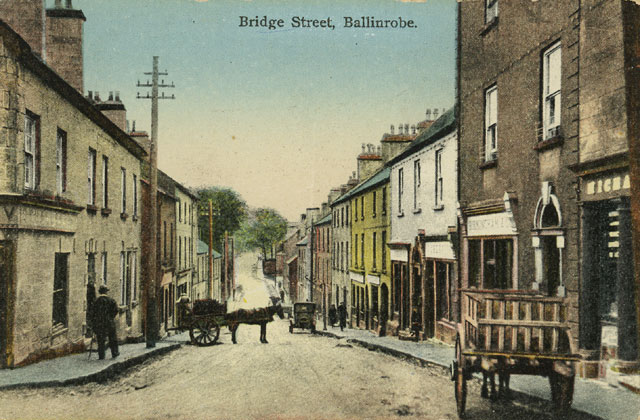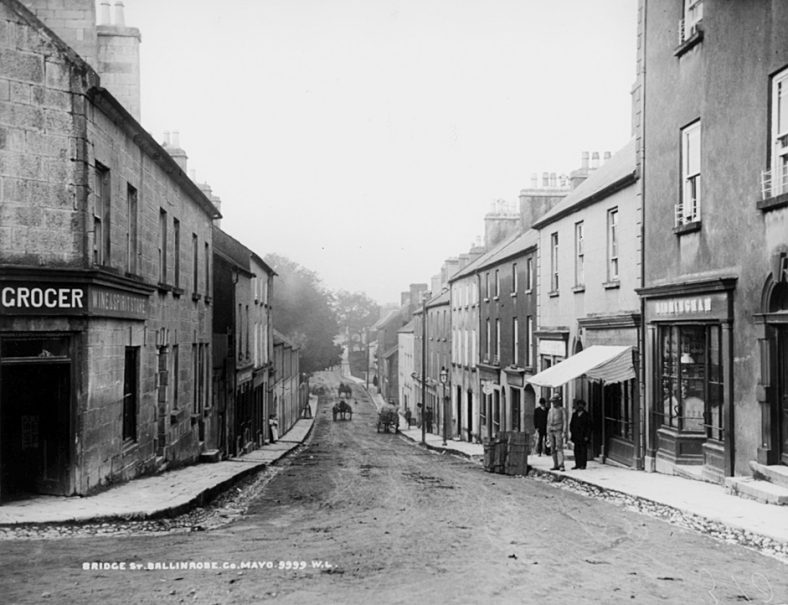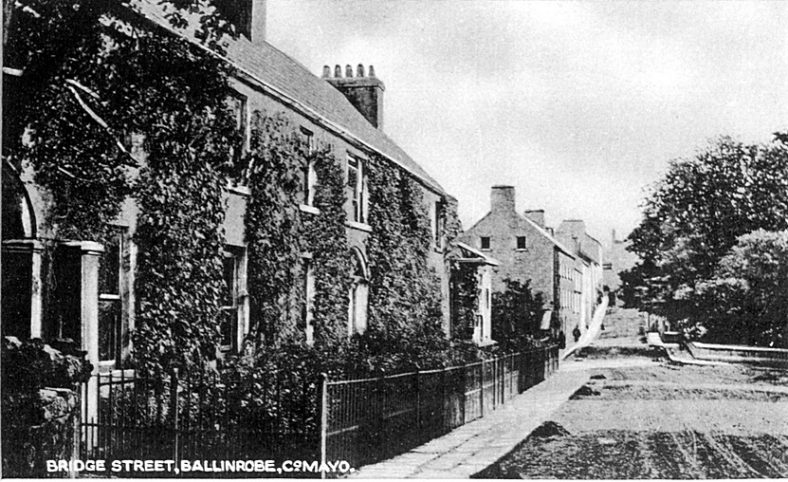The McCarthy family lived in the second house down from the archway, opposite what is now Willie Jennings’s butcher’s shop on Bridge St Ballinrobe, Co Mayo. In 1904 Michael McCarthy was from Leap in Cork and married a local girl Kate Higgins, and they went to live in Bridge St.
Parents
Kate’s mother was Mary Mellett from Cluain Aonach, just off the road to the lake; Mary died only 3 months after Kate was born, and Kate grew up on her grandparents’ farm in Cluain Aonach, and remained very close to the Mellett family all her life.
Ballinrobe was a breach-Gaeltacht
Kate’s mother tongue was Irish; Ballinrobe was a breach-Gaeltacht then and she had great stories of old folk customs e.g. if you were emptying a saucepan out the kitchen door you would shout “Bealach” (Fág a’Bealach) first, to warn the Síoga outside.
Michael and Kate McCarthy had 5 children; Mary, who was a secondary teacher, first in Ballinrobe, then in Eccles St, Dominican College in Dublin; Michael (who had a family in Galway including Peggy who married Bob Bradley; that’s the connection with that garage. Kate, a primary teacher in Dublin who married Jack Clynes from Athlone; Eugene who was a civil servant in Dublin: and Ellie, who became a Dominican nun, Sr. Aquinas.
Story from the war of independence
The Black and Tans were raiding houses randomly and the McCarthy’s got word that they were going to raid Bridge Street, they buried a picture of Robert Emmet in the back garden. I wonder if it is still there?
Move to Dublin
The father, Michael McCarthy was a civil servant in charge of Pensions, Customs and Excise etc. He had to move with his job to Dublin in 1934 but they loved Ballinrobe and returned there every summer with the Clynes children – Eoin, Maire, Kitty, Frances and Martin. Michael Senior died in 1943, but his wife Kate lived until 1969 and spent every summer in Ballinrobe, to meet her relations and friends (including her best friend from her childhood, Onnie Flannery from High St and really Ballinrobe was where her heart lay.
Her daughter Mary in particular also loved Ballinrobe, and the McCarthy and Clynes families spent several months every summer there until Mary died in 1996. (Eugene died in1999, Kate in 2007 and Ellie in 2008) Mary is buried with her parents in Ballinrobe churchyard.
Travel to Ballinrobe
In the early days, before we had a car, we would get the train to Claremorris and then transfer to the local train, the Ballinrobe donkey sadly closed in 1957 but a train with genuine character if limited velocity.
Croagh Patrick Pilgrims
Reek Saturday night was a wonder to behold, as hundreds of men from all over Mayo walked or cycled through Bridge St on their way to Croagh Patrick.
Fair Days
Fair Days before the Mart were, shall we say, an experience for city dwellers. Suffice it to say that good, non-leaking wellies were in order!
Bridge Street in the 1950’s & 60’s
Bridge Street was a much livelier place in the 1950s and 60s, and very much lived in, before people built bungalows and moved out to the “suburbs”. There were several shops including Staunton’s, Scahill’s, Jenning’s, Hession’s, Newton’s chemist’s shop, Callahan’s and the butcher’s shop run first by Willie Murphy and later by Willie Jennings.
Traffic at that Time
There was very little traffic (although our neighbour, 6-year old Dermot O’Rourke, son of Judy and Andy, was knocked down and killed by a car in Bridge St in August 1956; he was best friend of the current writer, who was aged 6 then. There were lots of youngsters on Bridge St e.g. the Treacys, the Jennings, the Carrolls (famous for the show band star Martin “Doc” Carroll and the Royal Blues; Doc because his father was the local GP.
Bicycle trips to Caher, Cushlough & Inishrobe
Trips on bicycles to swim at Caher, Cushlough and through the fields to Inishrobe were many and memorable, we had our own names for each part of the journey, the Hill of Difficulty, the Hill of Doom, Hen Bend etc. and there were so many little sweet shops that had to be visited e.g. Mickey Hession’s and Mrs Jennings on Bridge St, Ellen Derrig’s tiny shop opposite the garage on the Carnalecka Rd, and Mrs Murphy’s shop where the roads to Cushough and Caher divide; she had a son in the school for the blind in Drumcondra and my father Jack Clynes, who taught in a primary school near there, used to call to see him frequently.
Playing in the Area
We also spent many happy (and risky) hours playing cowboys and Indians in the partially collapsed ruin of the Power House (now replaced by apartments just before the eponymous Bridge on Bridge Street) where we also got to play with abandoned magnets – come to think of it we used to also play in the underground tunnels at the cavalry barracks beyond the Green; Health and Safety had not yet been invented, but somehow we survived, although no doubt psychologically scarred!
Trouble Ahead!
In the 1950s, there was very little work, and corner-boys (the “boys” might be in their 30s, 40s and 50s) were a feature of life, a fixture outside the courthouse. One of them, Gerry Sullivan of Bridge St was reputed to announce every summer when the Clynes children arrived More Trouble; I’m sure it was true, but probably relatively innocent trouble by today’s standards.
“The Hole in the Wall Gang are all dead now, but once they ruled the West”




No Comments
Add a comment about this page